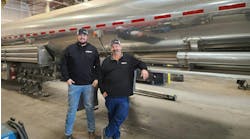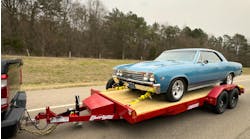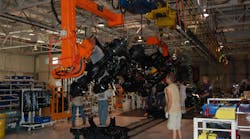FTR said it is “significantly” increasing both its Class 8 and commercial trailer forecasts for 2018, with the new estimates pegging North American Class 8 truck factory shipments for the year at 330,000 units and commercial trailers at 334,400 units.
This increase comes as truck orders averaged 41,500 units per month over the last three months, while trailer orders averaged 46,000 per month over the same period, noted Don Ake, FTR’s vice president of commercial vehicles.
“There is a capacity crisis occurring as surging freight growth is combining with lower productivity due to ELD implementation. Many shippers began having problems finding trucks to move goods [back in] September [and] conditions have continued to tighten. Now it is a nationwide issue,” he said in a statement.
“In early 2017, FTR’s freight models began to give warning signs about a critical capacity environment likely in the first quarter of 2018. That’s why our forecasts have been so optimistic for 2018 over the past year,” Ake explained. “When the economy exceeded expectations in the second half of 2017, those forecasts were increased further. And now with the tax reform package, the economy is generating even more freight and orders for trucks and trailers are pouring in.”
Barring any economic shock, FTR expects freight growth and equipment demand to continue to be sturdy into 2019. While capacitary utilization is forecasted to ease somewhat in late 2018, it will remain at historically high levels.
Ake note that in February, the preliminary figures for Class 8 order hit 40,200 units – a volume “much above expectations,” he said. And February’s Class 8 orders exceeded the 40,000-unit level for the second consecutive month, something that has not happened since November-December of 2014, Ake noted.
“The Class 8 market remains red-hot. The capacity crunch is transforming into a capacity crisis and many fleets of all sizes, in all markets, across the country are scrambling to add trucks as fast as they can. Robust freight growth is the primary driver and ELD [electronic logging device] implementation is just exacerbating a tough situation,” he added.
“It looks like fleets held back some orders from the fourth quarter to see if freight growth would continue and if ELDs were final,” Ake pointed out. “Now that the environment is more certain, the orders have been pouring in. This upturn looks strikingly similar to 2015, but is now expected to exceed it. Production is ramping up and should remain vibrant into next year.”
On top of that, FTR’s preliminary figures for trailer orders also hit the 40,000-unit range back in January for the third consecutive month and mark the first time in history that the industry has booked orders at levels in any three-month period, Ake emphasized.
““Motor carriers continue to add trailers as a way to increase total productivity,” he said. “All trailer segments are now looking very bright for 2018. Overall business confidence is surging due to tax reform and it’s making a hot market even hotter.”









